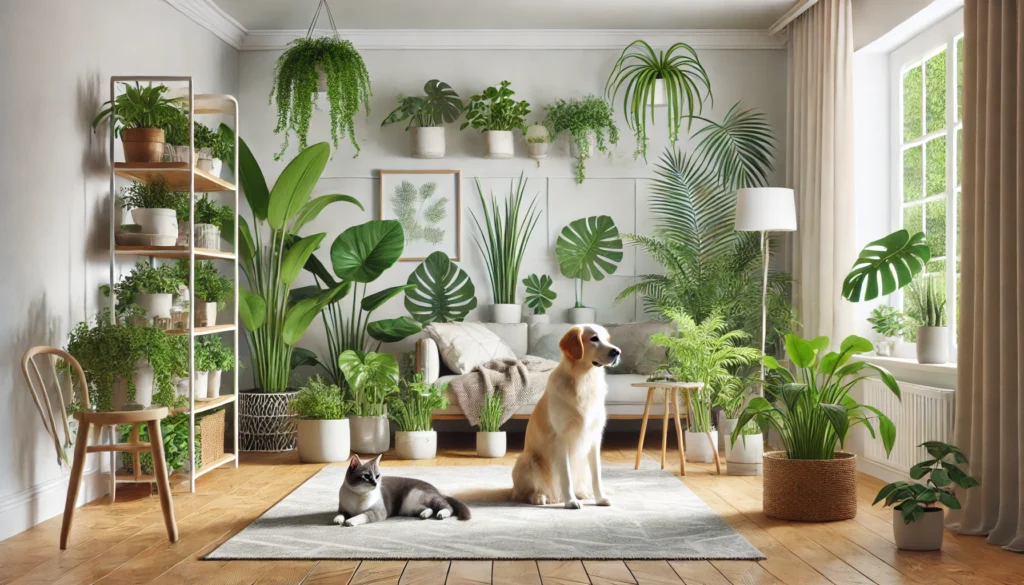Plants add beauty, calm, and fresh air to our indoor spaces — but for pet owners, they can also pose serious health risks. Many common houseplants are toxic to cats and dogs if chewed, licked, or swallowed. Fortunately, there are plenty of stunning and safe alternatives that can coexist peacefully with your furry family members.
In this guide, you’ll learn which indoor plants are safe for cats and dogs, tips for keeping plants pet-friendly, and how to avoid common hazards — so you can green your space without worry.
Why Pet-Safe Plants Matter
Dogs and especially cats are curious creatures. They explore their world with their mouths and paws. If you have plants within reach, there’s always a chance your pet might:
- Chew on leaves or stems
- Dig in the soil
- Knock over pots or hang from vines
Some plants can cause mild symptoms like drooling or vomiting, while others — like lilies or sago palms — are dangerously toxic.
Choosing safe plants ensures your pet stays healthy while your home stays green.
Top Pet-Safe Indoor Plants
Here are some of the most popular houseplants that are non-toxic to both cats and dogs, according to the ASPCA:
1. Spider Plant (Chlorophytum comosum)
- Hardy and air-purifying
- Loves bright, indirect light
- Often attracts cats who like to bat at the long leaves
2. Areca Palm (Dypsis lutescens)
- Soft, arching fronds
- Adds tropical elegance
- Non-toxic and great for corners or bright bathrooms
3. Calathea
- Stunning patterned leaves
- Thrives in medium light and humidity
- Non-toxic and low-maintenance
4. Prayer Plant (Maranta leuconeura)
- Leaves fold at night like “praying hands”
- Safe for pets and ideal for tabletops or shelves
- Does well in medium light
5. Peperomia
- Small, rubbery leaves in various shapes
- Compact and easy to grow
- Pet-friendly and ideal for shelves or hanging
6. Ponytail Palm (Beaucarnea recurvata)
- Despite the name, it’s a succulent
- Long curly leaves and a thick trunk
- Safe and very low maintenance
7. Boston Fern (Nephrolepis exaltata)
- Lush and bushy
- Non-toxic and great in bathrooms or kitchens
- Likes humidity and filtered light
8. Baby Rubber Plant (Peperomia obtusifolia)
- Thick, shiny leaves
- Grows upright and stays compact
- Safe and decorative on desks or counters
9. African Violet (Saintpaulia)
- Beautiful blooms in many colors
- Non-toxic to pets
- Prefers indirect light and regular watering
10. Bamboo Palm (Chamaedorea seifrizii)
- Graceful, airy fronds
- Pet-safe and air-purifying
- Grows well in partial shade
Tips for Keeping Plants and Pets Peacefully Together
Even with safe plants, it’s a good idea to set some boundaries and prevent accidental damage.
1. Elevate and Protect
- Place plants on high shelves or hanging baskets
- Use wall-mounted planters or tall plant stands
- Avoid wobbly tables where pets could knock them over
2. Distract and Redirect
- Offer pet grass or catnip for cats to chew
- Provide digging boxes for dogs who like to disturb soil
- Use scratching posts near plant areas to reduce curiosity
3. Use Pet-Safe Soil and Fertilizer
- Avoid using cocoa mulch or chemical-laden fertilizers
- Choose organic or pet-safe options labeled nontoxic
- Skip pesticides — they can linger on leaves even if the plant is safe
4. Prevent Overwatering and Mold
- Moldy soil can irritate a dog or cat’s stomach or respiratory system
- Use well-draining pots and water only when necessary
- Clean leaves regularly to prevent dust and pests
5. Watch for Chewing or Plant Play
- Monitor your pet’s behavior around new plants
- Gently discourage interest using deterrent sprays (pet-safe) or aluminum foil
- Reward good behavior with treats or play when they ignore plants
Toxic Plants to Avoid in Pet Homes
Some of the most common houseplants that are toxic to cats and/or dogs include:
- Lilies (extremely toxic to cats)
- Pothos (also known as Devil’s Ivy)
- Snake Plant
- Aloe Vera
- Sago Palm (highly toxic)
- Dieffenbachia (Dumb Cane)
- ZZ Plant
- Peace Lily
- Philodendron
- Monstera Deliciosa
Always check before introducing a new plant. The ASPCA has an extensive searchable list of toxic and non-toxic plants.
What to Do if Your Pet Eats a Plant
If your pet eats a plant and shows signs like vomiting, lethargy, drooling, or unusual behavior:
- Identify the plant immediately
- Remove access to the plant
- Contact your vet or the Animal Poison Control Center (APCC)
- Bring a sample of the plant if going to a clinic
Even with non-toxic plants, eating large amounts can still cause stomach upset.
A Green Home That’s Pet-Safe Too
With the right selection and placement, you don’t have to choose between a thriving indoor garden and a pet-friendly environment. Pet-safe plants give you the joy of greenery without the stress of toxic exposure — and they might just become your cat’s new favorite nap backdrop or your dog’s calming spot.
A home full of plants and pets? That’s the good kind of wild.






